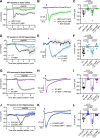A Biomimetic C-Terminal Extension Strategy for Photocaging Amidated Neuropeptides
- PMID: 37649440
- PMCID: PMC10510324
- DOI: 10.1021/jacs.3c03913
A Biomimetic C-Terminal Extension Strategy for Photocaging Amidated Neuropeptides
Abstract
Photoactivatable neuropeptides offer a robust stimulus-response relationship that can drive mechanistic studies into the physiological mechanisms of neuropeptidergic transmission. The majority of neuropeptides contain a C-terminal amide, which offers a potentially general site for installation of a C-terminal caging group. Here, we report a biomimetic caging strategy in which the neuropeptide C-terminus is extended via a photocleavable amino acid to mimic the proneuropeptides found in large dense-core vesicles. We explored this approach with four prominent neuropeptides: gastrin-releasing peptide (GRP), oxytocin (OT), substance P (SP), and cholecystokinin (CCK). C-terminus extension greatly reduced the activity of all four peptides at heterologously expressed receptors. In cell type-specific electrophysiological recordings from acute brain slices, subsecond flashes of ultraviolet light produced rapidly activating membrane currents via activation of endogenous G protein-coupled receptors. Subsequent mechanistic studies with caged CCK revealed a role for extracellular proteases in shaping the temporal dynamics of CCK signaling, and a striking switch-like, cell-autonomous anti-opioid effect of transient CCK signaling in hippocampal parvalbumin interneurons. These results suggest that C-terminus extension with a photocleavable linker may be a general strategy for photocaging amidated neuropeptides and demonstrate how photocaged neuropeptides can provide mechanistic insights into neuropeptide signaling that are inaccessible using conventional approaches.
Conflict of interest statement
The authors declare no competing financial interest.
Figures






Similar articles
-
The cholecystokinin gene is abundantly co-expressed with gastrin-releasing peptide, enkephalin and neuropeptide Y genes in a clonal human neuroepithelioma cell line.FEBS Lett. 1990 Jul 30;268(1):88-90. doi: 10.1016/0014-5793(90)80979-s. FEBS Lett. 1990. PMID: 2384178
-
Receptors of peptides as therapeutic targets in epilepsy research.Curr Med Chem. 2014;21(6):764-87. doi: 10.2174/0929867320666131119154018. Curr Med Chem. 2014. PMID: 24251562 Review.
-
Neuropeptides: metabolism to bioactive fragments and the pharmacology of their receptors.Med Res Rev. 2015 May;35(3):464-519. doi: 10.1002/med.21323. Epub 2014 Jun 3. Med Res Rev. 2015. PMID: 24894913 Review.
-
Ultrastructural studies on peptides in the dorsal horn of the spinal cord--I. Co-existence of galanin with other peptides in primary afferents in normal rats.Neuroscience. 1993 Nov;57(2):365-84. doi: 10.1016/0306-4522(93)90069-r. Neuroscience. 1993. PMID: 7509467
-
C-terminal amidated peptides: production by the in vitro enzymatic amidation of glycine-extended peptides and the importance of the amide to bioactivity.Enzyme Microb Technol. 1994 Jun;16(6):450-6. doi: 10.1016/0141-0229(94)90014-0. Enzyme Microb Technol. 1994. PMID: 7764886 Review.
Cited by
-
Principles and Design of Molecular Tools for Sensing and Perturbing Cell Surface Receptor Activity.Chem Rev. 2025 Mar 12;125(5):2665-2702. doi: 10.1021/acs.chemrev.4c00582. Epub 2025 Feb 25. Chem Rev. 2025. PMID: 39999110 Review.
-
Photochemically-enabled, post-translational production of C-terminal amides.Nat Commun. 2024 Nov 30;15(1):7162. doi: 10.1038/s41467-024-51005-5. Nat Commun. 2024. PMID: 39616180 Free PMC article.
-
Neuromodulator and neuropeptide sensors and probes for precise circuit interrogation in vivo.Science. 2024 Sep 27;385(6716):eadn6671. doi: 10.1126/science.adn6671. Epub 2024 Sep 27. Science. 2024. PMID: 39325905 Free PMC article. Review.
-
Next-Generation Drug Delivery for Neurotherapeutics: The Promise of Stimuli-Triggered Nanocarriers.Biomedicines. 2025 Jun 13;13(6):1464. doi: 10.3390/biomedicines13061464. Biomedicines. 2025. PMID: 40564183 Free PMC article. Review.
-
In vivo photopharmacology with light-activated opioid drugs.Neuron. 2023 Dec 20;111(24):3926-3940.e10. doi: 10.1016/j.neuron.2023.09.017. Epub 2023 Oct 16. Neuron. 2023. PMID: 37848025 Free PMC article.
References
-
- Smith S. J.; Smbül U.; Graybuck L. T.; Collman F.; Seshamani S.; Gala R.; Gliko O.; Elabbady L.; Miller J. A.; Bakken T. E.; Rossier J.; Yao Z.; Lein E.; Zeng H.; Tasic B.; Hawrylycz M. Single–Cell Transcriptomic Evidence for Dense Intracortical Neuropeptide Networks. Elife 2019, 8, e4788910.7554/eLife.47889. - DOI - PMC - PubMed
-
- Xiong H.; Lacin E.; Ouyang H.; Naik A.; Xu X.; Xie C.; Youn J.; Wilson B. A.; Kumar K.; Kern T.; Aisenberg E.; Kircher D.; Li X.; Zasadzinski J. A.; Mateo C.; Kleinfeld D.; Hrabetova S.; Slesinger P. A.; Qin Z. Probing Neuropeptide Volume Transmission In Vivo by Simultaneous Near–Infrared Light-Triggered Release and Optical Sensing. Angew. Chem., Int. Ed. 2022, 61, e20220612210.1002/anie.202206122. - DOI - PMC - PubMed

